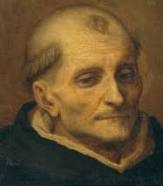
Born Antonio Pierozzi,,on 1 March 1389, our saint today was the son of Niccolo Pierozzi and his second wife, Tomasina. Antonio’s mother died when he was a little boy and Niccolo married again, but nothing is known of the woman who raised him. The family was a very pious one. Both a brother and a sister entered into religious life. Antonio was noted for his holiness at a young age, praying for up to an hour at a time. He seemed so serious that it was as if he was never really a child.
The young boy was very studious and his father taught him the hidden understanding of law. So, it was not a surprise when the boy spoke to John Domenici, one of the founders of the stricter congregation of the Dominicans, and asked to join at that time. Domenici, sensing the boy was too young, ordered him to read a very detailed legal document and memorize it before entering. A year later, Antonio was so conversant with the document that Domenici felt he should allow the boy into the congregation. In 1405, Antonio received the habit of the Dominican order at the priory in Fiesole, just outside of Florence.
Antonio so admired Domenici that he did whatever the good priest asked. And he continued throughout his training. During this time, from 1378 to 1417, the Great Schism was on. There were two popes, in Rome and Avignon. Domenici worked to solve this problem. When Pope Martin was elected, but no others, the schism was over. Domenici moved to Rome to assist the new pope in reorganizing the Church. This caused many of Domenici’s administrative duties to fall on the young shoulders. They had developed the stricter version of the order known as the Congregation of Tuscany. Antonio became prior of the Cortona house before he was 30 and served at Rome and Naples before returning to Florence.
From 1433 to 1449, Antonio was the vicar of the new Congregation. In 1436, he established the new Priory of St. Mark in Florence. The buildings were torn down and rebuilt. Antonio became prior in 1439-1444. In the decorating process, the famous artist, Fra Angelico, and his assistants painted frescos in the cells, including the one for Cosimo de Medici. In 1446, Antonio was named archbishop of Florence. He did not wish the position, due to humility. But eventually he took it.
The archbishop was mediocre at sermons. His specialty was analyzing the matter of conscience. He won the esteem and love of the people by his energy and gentleness, and by the resources he used in combatting the effects of plagues, earthquakes and cyclones. He planted wheat in the archbishop’s palace grounds, got the Republic to donate 3000 florins to feed the poor and other works to assist the people. He lived a life of austerity even as an archbishop. As spiritual head of the Florentine Republic, he was close to the Medicis, but the relationship was not necessarily harmonious. He served as ambassador to the Holy See in the 1450s.
St. Antonius was well known for his theological learning. He was a papal theologian at the Council of Florence 1439 – 1445. His writings were major developments in moral theology. They show an awareness of social and economic development. He argued that the state has the duty to intervene in mercantile affairs for the common good and to help the poor and the needy.
This good man died 2 May, 1459. Pope Pius II was on his way to the Council of Mantua when he heard of Antonius’ death. He stopped to say the funeral. The body was buried at St. Mark’s.
“…if those penitent have departed in the love of God, before they have made satisfaction by worthy fruits of penance for sins of commission and omission, the souls of these are cleansed after death by purgatorial punishments…”
Council of Florence, 1439

Recent Comments